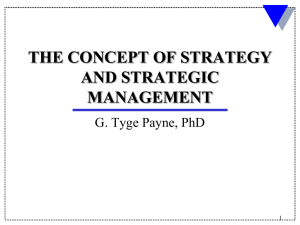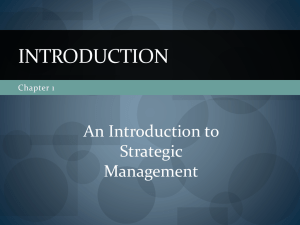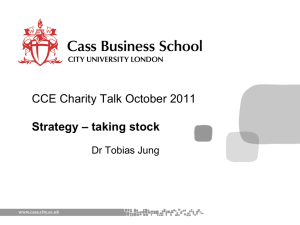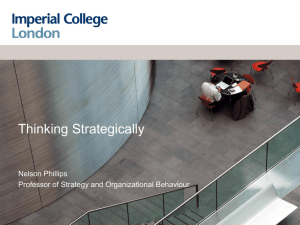4. Strategy making
advertisement
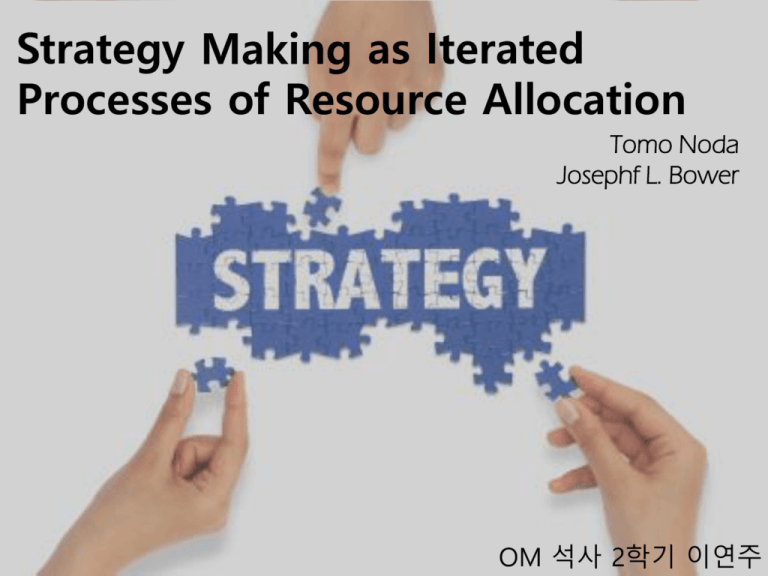
Strategy as Iterated Processes of Resource Allocation Tomo Noda Josephf L. Bower OM 석사 2학기 이연주 A Introduction genda Research Objective Methodology Strategy Making as Iterated Processes of Resource Allocation Toward a Formal Process Theory of Strategy Making in Large, Complex Firms. Discussions 1. Introduction • Strategy is a course of action consciously deliberated (Chandler, 1962; Andrews, 1971; etc) • Inherent organizational complexities and unpredictable environment How is strategy actually formed? • Findings from empirical studies : strategy is emergent from lower levels of organizations • Strategy process perspectives: strategy is ‘a pattern in a stream of decisions and action’ (Mintzberg & McHugh, 1985) 1. Introduction 1. Bower-Burgelman(B-B) Process Model Burgelman, Robert A. "A process model of internal corporate venturing in the diversified major firm." Administrative Science Quarterly (1983): 223-244. 1. Introduction 1. Bower-Burgelman(B-B) Process Model Burgelman, Robert A. "A process model of internal corporate venturing in the diversified major firm." Administrative Science Quarterly (1983): 223-244. 1. Introduction 2. intraorganizational ecological perspective • • Bottom-up resource allocation process Intraorganizational competition among bottom-up initiatives to survive by getting scarce corporate resources & top managers’ attention in the corporate context Variation Selection Strategic initiatives are identified and examined in the definition process impetus process by corporate context as ‘internal selection environment’ Reinforcement or modification of corporate context Strategic initiatives outside scope of current strategy Defining strategic context for new initiatives Changes in organizational learning, competence, etc. to lead top management to recognize that a major change in strategy is necessary and feasible Strategic initiatives seeking resources for projects that correspond to internal selection pressures Initiative selected through administrative mechanisms and cultural influencing Integrated in ex ante vision Autonomous Induced Retention Burgelman, Robert A. "Intraorganizational ecology of strategy making and organizational adaptation: Theory and field research." Organization science 2.3 (1991): 239-262. 2. Research Objective Research Questions 1. Why is it that firms, facing similar opportunities, respond differently and come up with different strategic commitments to the business? 2. How and why do managerial activities at multiple levels of organization, which add up to such different emergent concepts of corporate strategy, differ among these firms? Research Objective 1. To fill the gap by comparing multiple firms 2. To extend the B-B model to a comparative analysis of a single business across multiple firms 3. Methodology •2 of the 7 regional holding companies(RHCs) by the breakup of AT&T Significant similarities •Initial local cellular markets were similar: market size, drive intensity, income level Similar business opportunity (even among 7 RHCs) 3. Methodology • Largest of the seven RHCs in domestic wireless revenues and international wireless operations measured by the number of POPs • Nation’s second largest paging operator • Global/mobile strategy: active in a wide range of wireless communication businesses • Smallest in domestic wireless revenues of the seven companies • Fairly active international cellular operations, but more committed to broadband and multimedia businesses • No strategic emphasis on its wireless communications businesses 3. Methodology Research Methods • Retrospective field studies • Interviews • Guided by the B-B process model of strategy making in a multilevel, multibusiness organization Iterated B-B process model: to capture multiple, sequential projects Propositions regarding a formal process of strategy making in large, complex firms 4. Strategy making 4. Strategy making: 1st period(Getting started) 4. Strategy making: 2nd Period(Unexpected growth) 4. Strategy making: 3rd Period(Full Bloom) 5. Toward a theory of strategy making 1.The role of corporate context in strategy making • P1a: Top managers exercise a critical influence on the strategic initiatives of lower-level managers by setting up the context in which these managers make decisions and take actions • P1b: Both strategic and structural contexts influence bottom-up initiatives in the definition process, and shape resource allocation in the impetus process in a way that virtually defines a course of business development and subsequent emergence of a corporate strategy for the new business • P1c: A firm’s structural context is relatively stable over time, and its persistent impact on the subsequent business development process constrains the discretion of top managers who may want to change the firm’s course of actions in response to the development of technology and the market for a new business Q. Application to the types of strategy by Mintzberg(1985)? 5. Toward a theory of strategy making 2. Escalation (de-escalation) of a firm’s strategic commitment • P2: In the case of a new business development that involves a high degree of uncertainty, the iterations of the resource allocation process generate a pattern of escalation or de-escalation of a firm’s strategic commitment based on early results from operations that confirm or disconfirm the premises of the first investment and the credibility of the champions 5. Toward a theory of strategy making 3. The determination of strategic context • P3: In the case of successful business development, continuous, incremental learning of top managers during business development, and the resulting fine tuning of strategic context shift resource allocation and precede the articulation or change in official statements of the corporate strategy for the new business Incremental view of strategy making Deliberate strategy vs. Emergent strategy (Mintzberg,1985) 6. Discussion 1. 저자들은 이 모델이 multi-level management가 있는 대기업에 적용된다는 boundary condition을 제시한다. 그렇다면 작은 기업에서는 이 프로세스가 어 떻게 달라질까? - 작은 기업의 business manager들도 top manager의 의도와 독립적으로 기능 할 수 있을까? 2. 기술의 발전 속도나 산업의 성장속도가 다른 산업에서도 이 framework가 그대 로 적용될 수 있을까? 3. ‘Strategy making as iterated process of resource allocation’이 Mintzberg(1985) 의 ‘emergent strategy’에 대해 시사하는 바는 무엇일까?
